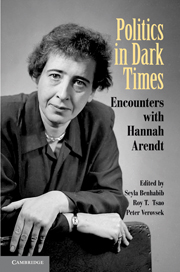Book contents
- Frontmatter
- Contents
- Notes on Contributors
- Introduction
- Part I Freedom, Equality, and Responsibility
- Part II Sovereignty, the Nation-State, and the Rule of Law
- 6 Banishing the Sovereign? Internal and External Sovereignty in Arendt
- 7 The Decline of Order: Hannah Arendt and the Paradoxes of the Nation-State
- 8 The Eichmann Trial and the Legacy of Jurisdiction
- 9 International Law and Human Plurality in the Shadow of Totalitarianism: Hannah Arendt and Raphael Lemkin
- Part III Politics in Dark Times
- Part IV Judging Evil
- Index
9 - International Law and Human Plurality in the Shadow of Totalitarianism: Hannah Arendt and Raphael Lemkin
Published online by Cambridge University Press: 05 June 2012
- Frontmatter
- Contents
- Notes on Contributors
- Introduction
- Part I Freedom, Equality, and Responsibility
- Part II Sovereignty, the Nation-State, and the Rule of Law
- 6 Banishing the Sovereign? Internal and External Sovereignty in Arendt
- 7 The Decline of Order: Hannah Arendt and the Paradoxes of the Nation-State
- 8 The Eichmann Trial and the Legacy of Jurisdiction
- 9 International Law and Human Plurality in the Shadow of Totalitarianism: Hannah Arendt and Raphael Lemkin
- Part III Politics in Dark Times
- Part IV Judging Evil
- Index
Summary
Hannah Arendt and Raphael Lemkin were witnesses to the twentieth century. They both experienced the dislocating transformations on the European continent as a consequence of two world wars; lost their states as well as their homes in this process; narrowly escaped the clutches of the Nazi extermination machine; and made it to the New World through sheer luck and fortuitous circumstance. Their thought is marked by the cataclysms of the last century, and they have in turn emerged as indispensable interlocutors for all of us in understanding this past.
Arendt and Lemkin were contemporaries and there are astonishing parallels in their early biographies. She was born in Hannover in 1906 (d. 1975) and grew up in Koenigsberg in East Prussia. After World War I, the Polish Corridor was created and cut East Prussia and Koenigsberg off from the rest of Weimar; in 1945 Koenigsberg was occupied by the Soviets and renamed Kaliningrad. Lemkin was born in Bezwodene in 1900, then part of Tsarist Russia. Between the two world wars (1918–1939), Bezwodene became part of Poland and today is Bezvodna in Belarus.
- Type
- Chapter
- Information
- Politics in Dark TimesEncounters with Hannah Arendt, pp. 219 - 244Publisher: Cambridge University PressPrint publication year: 2010
- 5
- Cited by



